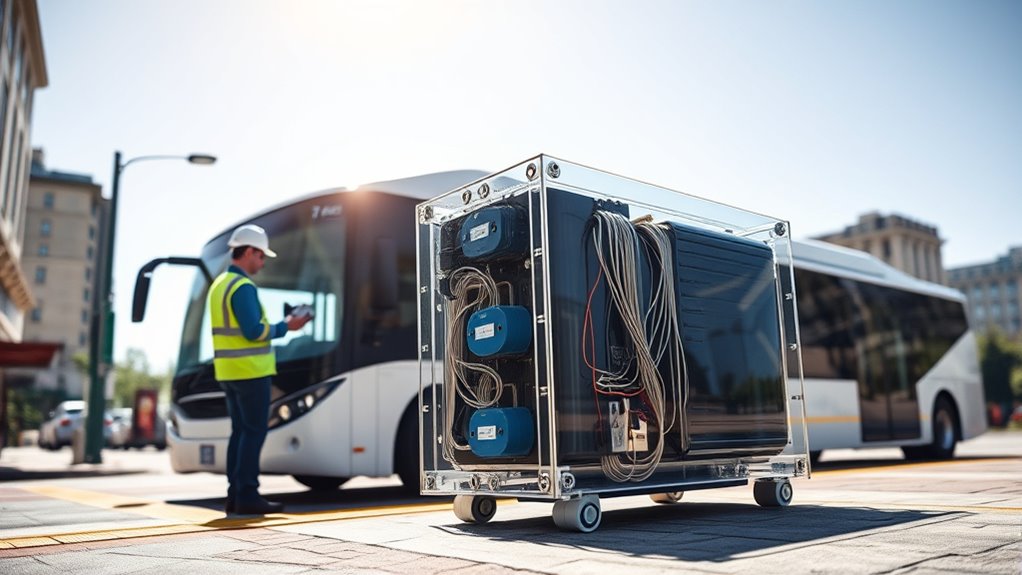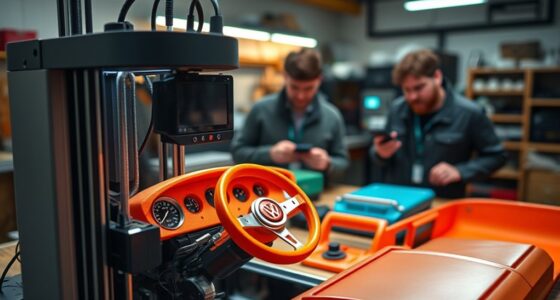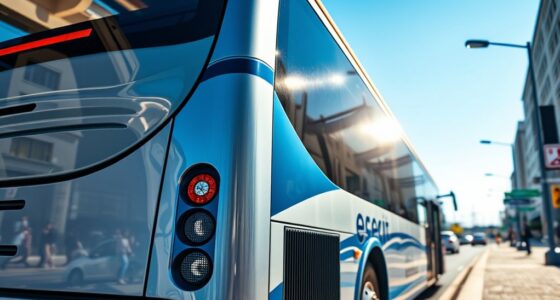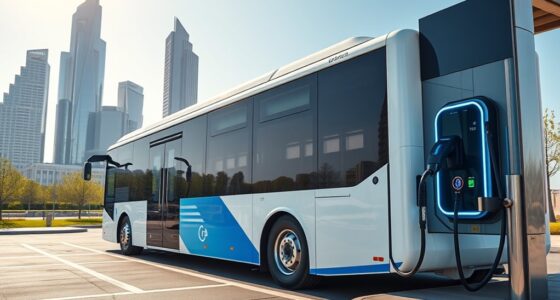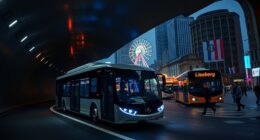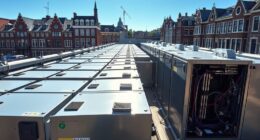The development of ultra-capacitors for electric buses focuses on creating rapid, reliable energy storage that supports quick charging and efficient operation. These advanced devices capture regenerative braking energy and deliver power instantly, reducing dependence on traditional batteries. Innovations aim to increase energy density, lifespan, and climate stability, making buses more sustainable and cost-effective. If you keep exploring, you’ll discover how these advancements are transforming urban transit and shaping cleaner, smarter transportation systems.
Key Takeaways
- Advances in materials and nanotechnology have enhanced ultra-capacitors’ energy density and lifespan for bus applications.
- Integration of ultra-capacitors enables rapid charging and regenerative braking, optimizing electric bus efficiency.
- Hybrid and high-energy supercapacitors are being developed to extend travel range and power delivery.
- Innovations focus on improved temperature stability and durability for reliable operation in diverse climates.
- Ongoing research aims to reduce costs and streamline manufacturing, promoting widespread adoption in urban transit systems.
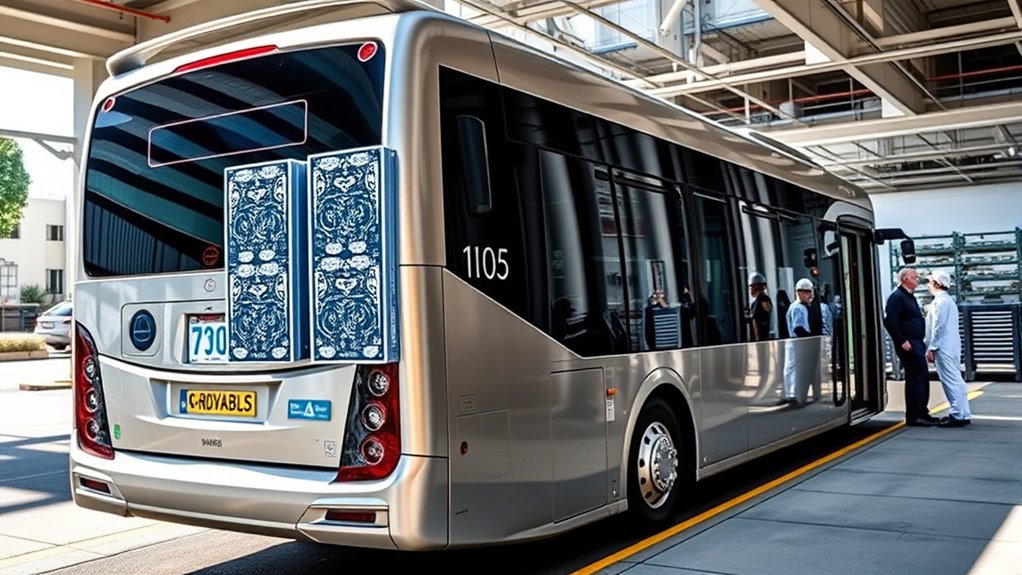
Ultra-capacitors are revolutionizing electric bus technology by providing fast, reliable energy storage. Unlike traditional batteries, they store energy electrostatically, allowing for rapid charging and discharging. This quick energy transfer makes them ideal for urban transit, where buses frequently brake and accelerate.
Ultra-capacitors enable rapid, reliable energy storage for efficient urban bus transit.
When you apply regenerative braking, ultracapacitors efficiently capture the energy that would otherwise be lost, storing it for immediate reuse. This capability not only boosts operational efficiency but also reduces the strain on the main batteries, extending their lifespan.
You’ll find that ultracapacitors come in different types, each suited for specific applications. Electric Double Layer Capacitors (EDLC) are the most common, storing energy electrostatically and providing high power density. Hybrid capacitors combine EDLC with battery technology, offering both quick bursts of power and higher energy capacity.
Companies like Aowei Technology develop ultracapacitors that deliver high actual energy availability and boast long lifespans, making them particularly attractive for public transportation. High-Energy Supercapacitors (HESC) push this further by providing higher energy densities, enabling buses to travel longer distances between charges.
Integrating ultracapacitors into electric bus design has become increasingly sophisticated. For instance, the Chariot e-Bus employs a 12-meter low-floor design with ultracapacitors as the primary energy storage system, allowing for rapid charging and efficient operation.
Collaborations between manufacturers like Higer Bus and ultracapacitor suppliers are advancing the development of more efficient, environmentally friendly buses. Some buses utilize wheel hub motors, which benefit from the quick energy release of ultracapacitors, reducing maintenance and enhancing efficiency.
Central electric motors then supply the necessary power for bus operation, optimized by the ultracapacitors’ rapid charge capabilities.
Performance-wise, ultracapacitor-equipped buses can charge in just minutes, making them suitable for busy urban routes with frequent stops. Their ability to quickly capture regenerative braking energy helps extend driving range and improve overall energy efficiency.
You’ll notice that these buses can often operate without overnight charging, which cuts down on operational costs and infrastructure needs. They also contribute considerably to reducing emissions, supporting cleaner cities and sustainable transportation initiatives.
From a technological perspective, ultracapacitors offer several advantages. They’ve a lifespan exceeding ten years, require less maintenance, and remain stable across various weather conditions.
Additionally, ongoing research in yarn for scarves and other fields continues to inspire innovations in energy storage materials, leading to more efficient ultracapacitors in the future.
The fast-charging feature allows buses to recharge at terminals without the need for overhead power lines, simplifying infrastructure and reducing costs. Their durability and temperature stability make them reliable in different climates and environments.
As technology advances, ultracapacitors continue to play an essential role in making electric buses more efficient, environmentally friendly, and suitable for widespread adoption in urban transit systems.
Frequently Asked Questions
What Are the Environmental Impacts of Ultra-Capacitor Production?
You should know that ultra-capacitor production impacts the environment mainly through energy use and supply chain choices. Using eco-friendly materials and efficient manufacturing reduces pollution, while recycling and waste management help limit waste.
However, sourcing raw materials responsibly and minimizing emissions during production are essential to lessen environmental harm. Overall, adopting greener processes and sustainable practices can markedly reduce the ecological footprint of ultra-capacitor manufacturing.
How Do Ultra-Capacitors Compare Cost-Wise to Traditional Batteries?
You’ll find that ultra-capacitors cost considerably more upfront than traditional batteries, sometimes up to 275% more. However, they save you money over time because of lower operating costs, less maintenance, and faster recharging.
While the initial expense is higher, their durability and efficiency can make them more economical in the long run, especially for applications like city buses with frequent stops and short routes.
Are Ultra-Capacitors Safe for Long-Term Urban Bus Operations?
You might wonder if ultra-capacitors are safe for long-term urban bus use. They are, thanks to their carbon-based materials, which are safer and less prone to thermal issues.
They also include safety features like short circuit protection, are chemically stable, and can handle millions of charge cycles without degradation.
Their high efficiency, quick charging, and lightweight design make them a reliable, safe choice for continuous urban bus operations.
What Are the Maintenance Requirements for Ultra-Capacitor Systems?
Your ultra-capacitor system needs minimal maintenance. You won’t deal with battery degradation or complex charge controls.
There’s no need for thermal management or engine repairs. Its modular design allows easy replacements, and high cycle life means fewer parts wear out.
You avoid extensive depot space and fire safety measures. Overall, you’ll experience lower operational costs, reduced downtime, and reliable performance, making maintenance straightforward and cost-effective.
How Scalable Is Ultra-Capacitor Technology for Large Fleet Deployments?
Imagine deploying a fleet of 100 electric buses using ultra-capacitor technology. You’ll find it highly scalable because of its rapid charging, lightweight design, and cost efficiency.
Ultra-capacitors support large capacities, quick recharge times, and integration with AI for energy management.
Plus, lower infrastructure costs and environmental benefits make expanding a fleet straightforward, sustainable, and economically viable for large-scale urban transit systems.
Conclusion
As you consider the future of electric buses, ultra-capacitors emerge as a game-changer, offering rapid charging and high power density. Don’t you want a cleaner, more efficient transit system? With ongoing advancements, ultra-capacitors could soon revolutionize urban transportation, making it more sustainable and reliable. So, aren’t we ready to embrace this technology and drive toward a greener, smarter world? The potential is right here—are you ready to be part of the change?
